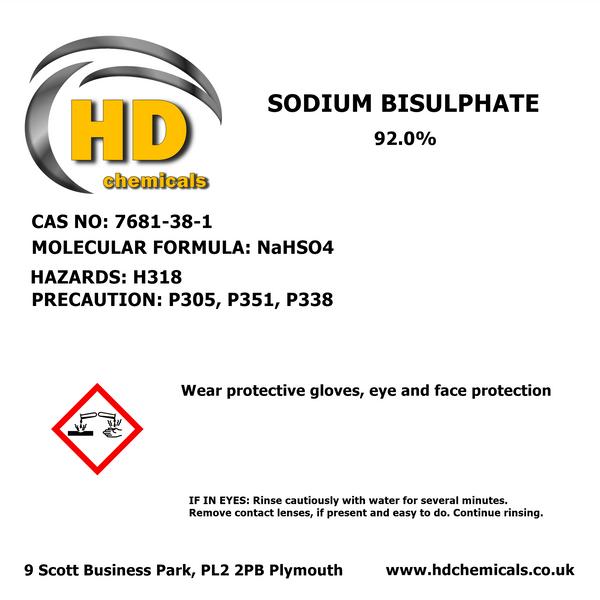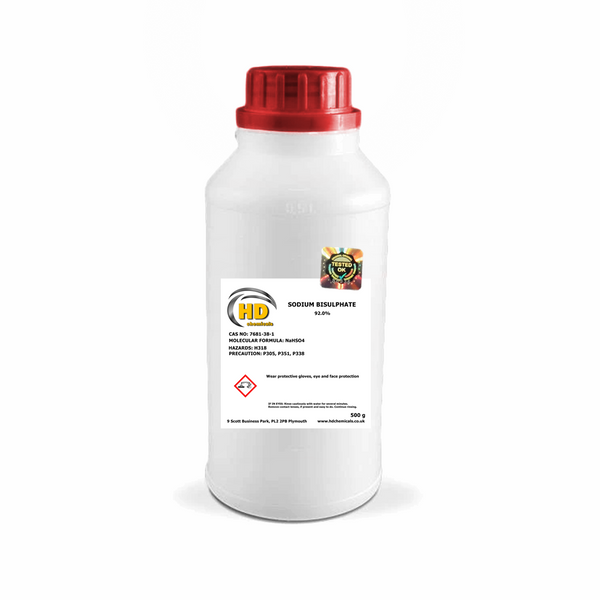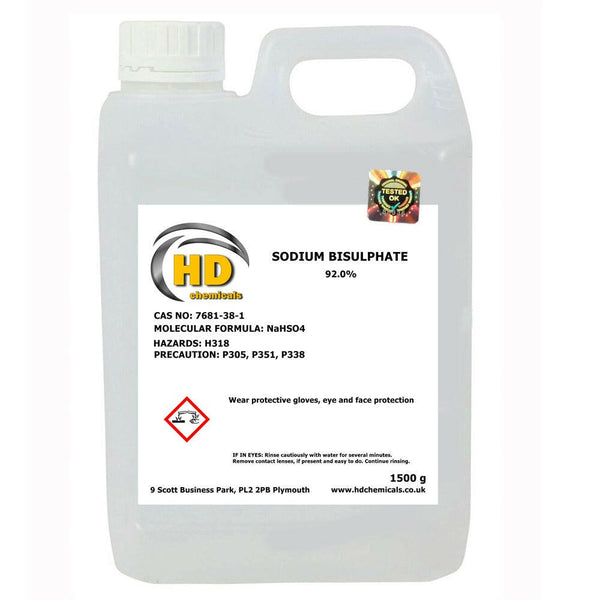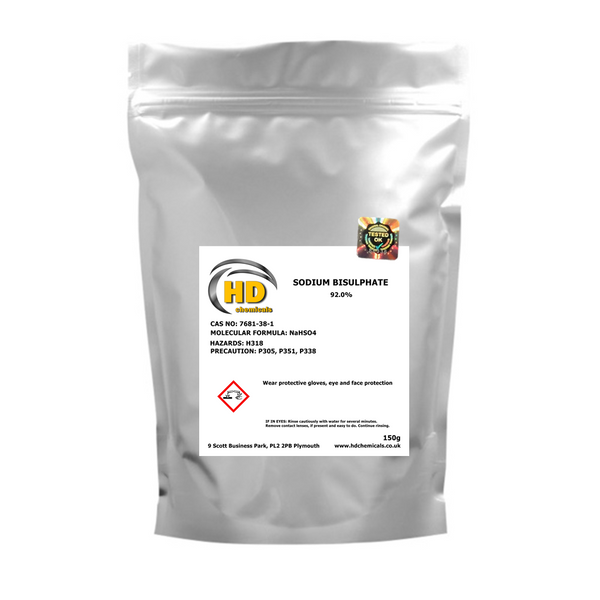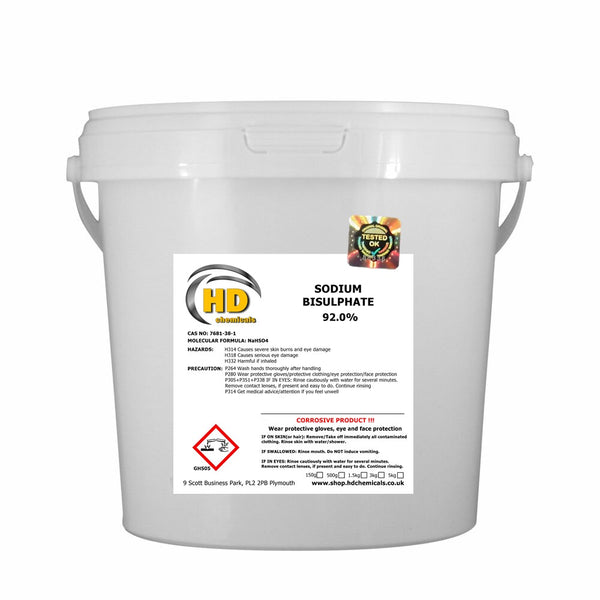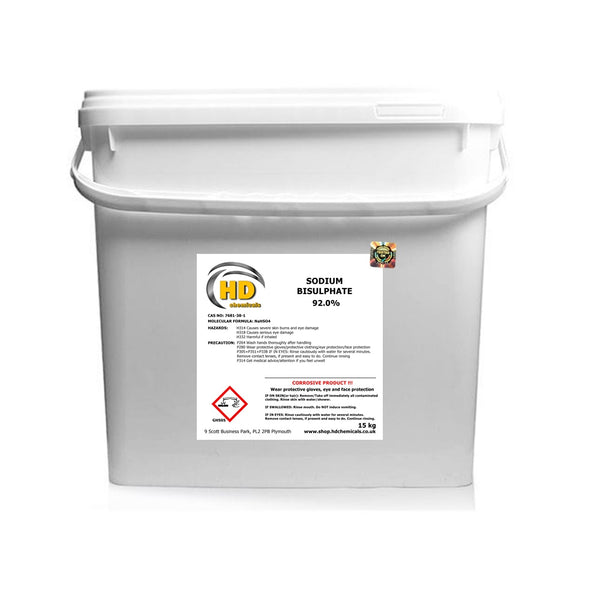Sodium Bisulphate 92%
Sodium Bisulphate 92%
Properties and specification:
- CAS No: 7681-38-1
- EINECS: 231-665-7120.06 g/mol
- Molecular weight: 120.06 g/mol
- Formula: NaHSO4
- Appearance: In the form of spherules white or slightly yellow.
- Solubility in Water: 1080g/l @ 25 C
- Density: 2.742 g/cm3
- Melting point: 315 C decomposes
- pH: 1.2 - 1.3 @ 1.2% w/w solution
What is Sodium Bisulphate?
Sodium Bisulphate is an acidic salt solution with the formula NaHSO4. It comes about by the partial neutralization of sulfuric acid and an equivalent sodium base, usually hydroxide or chloride. It is an odourless, slightly yellow or spherules white, and relatively dry granulated compound. It is also stable under normal conditions but highly soluble in water. In addition, it has a molecular weight of 120.06g/mol and is corrosive to metals and tissues.
What Is The Common Name For Sodium Bisulphate?
Sodium Bisulphate is also commonly known as Sodium hydrogen sulfate. This solution goes by several names, usually starting with the prefix 'sodium' hydrogen sulphate, sodium acid sulfate, hydrogen sulphate, acid sulphate, acid sodium bisulphate, bisulfate of soda, and a dry acid.
What Is Sodium Bisulphate Used For?
Sodium bisulphate comes in 500g and 1500g sizes and can be used for the following:
Reducing Alkalinity and PH in Swimming Pools
Sodium bisulphate is known for its ability to control the pH levels in swimming pools. Pool owners prefer this acid for its safety over muriatic acid. It is also easier to store and more user-friendly, allowing the added chlorine to work effectively. The ideal pH of pool water should be 7.0-7.6 and total alkalinity between 80 and 120ppm.
When using dry acid sulfate to balance pool pH, you should pre-dissolve the solution by adding the dry acid into a large plastic bucket of water. When it dissolves, pour the acid solution into the deep end of the pool when the pump is on and running. Retest the pH of the water in 4 hours and add more acid if needed. This solution is essential in making cleaning products such as disinfectants and surface cleaners to reduce pH levels. Dry acid is also used in the production of toilet cleaning agents.
As a Preservative
It is also commonly used as a preservative or food additive in meat processing, dietary supplements, and drugs. It is used as a food additive to make the dough rise. It has also recently become important in the prevention of the browning of fresh-cut produce. Manufacturers use this solution as a feed additive for pets. This solution's food-grade quantities are present in food products, including beverages, condiments, sauces, and fillings. Furthermore, it is sometimes used instead of malic, citric, or phosphoric acids as it lowers the pH without giving off a sour taste.
In Textile Production
In the textiles industry, dry acid is added to velvet cloths made with a silk backing and a pile of cellulose-based fibre to make burnout velvet. The acid is applied to the fabric and heated. The cellulose-based fibres become brittle and flake away, leaving burned-out areas in the finished material in beautiful patterns.
In Metal Pickling
Another use of this wonder acid is in the removal of fire scales from heated metal. This can be done by preparing a pickle solution. The solution can be a 30% solution. That is, 300grammes of acid per litre of water. Leave the metal in the pickle until the surface appears white and free of fire scale. It is important to note that it should be kept warm but not boiling. The warmer the solution, the faster the process takes place. The optimum temperature is 57 degrees Celsius to 95 degrees Celsius. You should avoid putting iron into the pickle, as this will impart a copper tone to sterling silver.
The uses highlighted above are some of the most popular uses of this product. Some of its other uses include:
-As an acid cleaner for industrial factories and breweries
- As a preservative for soil and water samples in analytical laboratory analysis
-The dehydration of castor oil
- Glass polishing
- In the mineral oil industry for the extraction of nitrogen compounds from hydrocarbons (gas scrubbing)
- As a bleach in photography (when mixed with potassium dichromate).
FREQUENTLY ASKED QUESTIONS
Is Sodium Bisulfate A Strong Acid?
This aqueous solution is highly acidic. It reacts violently with strong bases and oxidizing agents. Due to its strong acidic nature, you may experience irritation in the eyes and skin upon contact with the solution.
Is Sodium Bisulfate Toxic?
This solution is irritating to the eyes and skin due to its strong acidic nature. At high concentrations, it can cause serious eye damage upon contact. Inhaling, ingesting, or skin contact causes severe injuries and can lead to death. When heated, the solution emits poisonous gases.








